Winks to the automotive sector in the Basque Country
Please, before continouing, I recommend you to read my previous post, if you haven’t already done so, what I comment on the first rooms of the Car Exhibition at the Guggenheim Museum in Bilbao. There you can see the contents and reflections that I made during the tour of the rooms called: “Beginnings of the automotive industry”, “Sculptures on the road” and “Popularization of the private car”. And with this post… we will continue the route through the following rooms… are you coming?
Luxury Sport Cars
When entering the 4th room of the exhibit and I saw a car with wings, I said to myself: I know this car… And I smiled when I saw that it was from a Bilbao collector. I don’t know why I felt close, known. Probably I was still in the clouds and seeing a car with wings I had no doubt that I was in another world. This Mercedes-Benz 300 SL Coupe is one of the first supercars produced in history. It has what it takes to be a sports car, in addition to being comfortable and aesthetic, it must be easy to drive and fast on the roads. Due to its success on public roads and its magnificent design, the North Americans requested it as a touring car. He had as a nickname, “Widowmaker” (maker of widows), even though one of the key values that Benz imposed on its entire brand was safety, before speed.

Mercedes-Benz 300 SL Coupe
The “gull-wing” shapes of the doors of this Mercedes Benz are due to the construction of a cage-shaped tube chassis like a racing car, where the safety of the driver and co-driver was a key objective. In the competition model the doors only reach the roof and the windows, so it was quite difficult to get in or out. And you have to unlock and tilt the steering wheel to get your legs in or out. For sports models, as you can see, the doors reach lower, seeking comfort for access. Of the 1400 cars built of the 300 model, only 24 are SL (super light) like this one we see at the expo. The SLs could reach today 8 million dollars value. In fact, recently, in a private auction, a Mercedes-Benz 300 SLR Uhlenhaut Coupé ‘Silver Arrow’ has set a record of 135 million euros.
Finally the sky cleared up for me, and I remembered that I may have seen this car before in Barakaldo, near Bilbao, at the Aguinaga Museum of classic cars of the Mercedes Benz brand, in a building rehabilitated by the successors of the renowned architect José María Smith from Bilbao. José Aguinaga Goiri opened the German manufacturer’s first dealership in Baracaldo in 1945. This car is not his, but it can be seen here from time to time. I suggest you include this “walk through the stars” in your visit plan for Greater Bilbao.
The MOMA museum is also present in some way in this exhibition. In addition to the VW Beetle that you will see in the Popularization room; In the Sports room, we have a Jaguar E-Type from 1963. Both cars, considered as objects of art, are part of the permanent exhibition of the Museum of Modern Art in New York, a Museum having only 6 cars in its entire collection. Its hallmarks are design, dynamics, speed, a famous phrase by Enzo Ferrari as the “…most beautiful ever made“, and a first place in The Daily Telegraph’s list of the “100 most beautiful cars” in the world. By the way, others from that list are present at this expo. As an archetype of sports luxury, look at the leather seats and the wooden steering wheel. And as I told you, I love cars with those long hoods, and this one fascinates me. There is currently a version called the Jaguar E-Type Concept Zero, which Prince Harris used when leaving his wedding.
The British sense of humor is present in the car exhibition at the Guggenheim Museum in Bilbao. Sir Austin Danger Powers, the British spy created and portrayed by comedian Mike Myers as a parody of the James Bond films, drives a “Shaguar” alongside Beyoncé in the 2002 film Austin Powers in Goldmember. A decorated Jaguar E-Type with the British flag. And right next to it in this exhibit is the original Aston Martin DB5 that James Bond used in the 1964 Goldfinger movie and many others! A unique opportunity for fiction in the real world that you cannot miss! The design of its superlight aluminum body due to Touring relates it to the Pegasso sedans.
In addition to Sean Connery, this car was driven by Roger Moore in an episode of the series El Santo in 1964, but in its original red color. Paul McCartney bought one in 1965. Nowadays, updated ones are sold with all the gadgets that the spy car had, but what always impressed me the most was the telephone, and we have that solved now. He was as protagonist of the films as James Bond himself because of the emotions that he has made us live in the cinema, and not only because of his aesthetics. At the expo we can see some of the moments where the car appears on the big screen. I missed the fact that the devices that make this car famous are not visible, in some way. And I don’t mean seeing them on screen.
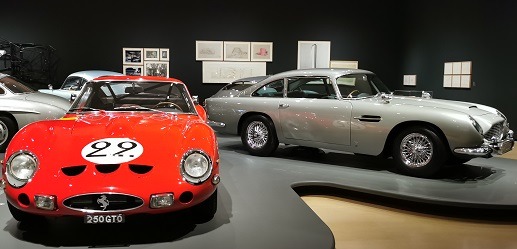
Ferrari 250 GTO y Aston Martin DB5
We will never know if it was because of envy, ego or by chance. Enzo Ferrari strove to bring all his artillery to the roads with the: Ferrari 250 GTO. What we do know is that he did it to compete against the Shelby Cobra, Aston Martin and Jaguar brands, which were the best in the GT category. It is in the list of “Best Sports Cars” of all time, and number 1 in the list of “Greatest Ferraris of all time“. It established itself with first and second place in the 1963 Tour de France. The French driver Jean Guichet, in addition to winning this race, was also the first owner of one of these cars, which has recently been sold, and is one of the most expensive in the world. The first owners, of the only 36 manufactured, were selected by Enzo Ferrari himself.
The Ferrari 250 you see in the show is owned by Nick Mason, who is himself a mix of art and automotive. His father was a filmmaker and used a black Bentley as a camera car; He was a great car collector. Very close to the time this car was first raced, Mason was studying architecture with Roger and Rick, and they were creating the band Sigma 6, which would later become Pink Floyd. He collects classic cars, he’s a car racer, and he says he doesn’t play music when he drives to listen to the engine. In the car exhibition at the Guggenheim Museum in Bilbao, in addition to his car, you can hear the sound of various car engines created by Mason in an installation in the corridor that takes you to the last room: Future.
Another car fanatic architect is Frank Lloyd Wright, who devised a building specifically geared towards motorists in 1924. At the expo, in front of the Porche, you can see the plans for this design. The idea did not prosper but the design of its ramps can be seen today in the Guggenheim Museum in New York. Photography is also an art that is nourished by the automotive industry. We can see a collage of photos of different specific views of the steering wheel of a Mercedes Benz and the road, from the perspective of its driver. A fictional reality created by David Hockney. In addition, the tires have their space in the expo, in the background there is a relief in white silicone and 7 serigraphs of computer-generated drawings of 5 tires. Without a doubt, the relief of Richard Hamilton is the most striking.
I took one last look at the sports cars and realized that I had forgotten to admire a 1950 Porsche 356 PRE-A that was in the room (I have to go back to get a good look), but my watch told me to move on. And my mind was still looking for some connection with the Basque Country for this room. I remembered that Bilbao’s Gran Vía served as a street circuit for the 1953 Firestone Rally where this car was presented, and in July 2005 for the World Series by Renault and the Formula Renault European Championship. And of course, the Lasarte Circuit, also known as San Sebastián, which we already mentioned in the first room.
Do not confuse the Circuit de la Sarthe, where the 24 hours of Le Mans are held, with the one in Lasarte. In the Basque Country the following were held: the San Sebastián Grand Prix between the years of 1923 to 1925 and from 1927 to 1930; and the Spanish Grand Prix from 1926 to 1930, and from 1933 to 1935. Also the 1926 European Grand Prix. At the 1928 Lasarte Grand Prix, a car called Donosti (as the city of San Sebastian is also known) opened the circuit as a pace car. It was designed and built by locals Agustín Mañero Alonso and Gregorio Mendiburu, owners and partners of Garaje Internacional. It is considered by some as one of the best cars designed in Spain. It could be seen in 2018 at the exhibition held by the Basque Automotive Cluster (Acicae) for its 25th anniversary.
Visionaries of the Movement
The car exhibition at the Guggenheim Museum in Bilbao continues with the Visionaries room. It is disconcerting to read that name and see at first glance that all the cars on display are contemporary. But soon you start to get out of that error when you read and see that all except the Formula 1 one were designed more than 50 years ago! They are prototypes, concept cars or Dream cars. Cars that explore new ways of driving, energy, bodywork design, interior space, or vehicle control, among others. In short, cars that made a significant leap with respect to what was being developed in the automotive industry at the time of its conception and construction. They are those cars that broke “the state of the art”. Or did they take it?
The first “car”? you meet is more like a rolling zeppelin than an automobile. Its shape is very striking, and so is its name: Dymaxion Car no.4. It is a current copy of a design… from 1933! Norman Foster compiled the plans for the Dymaxion 4D Transport, of which 3 prototypes had been built. He also arranged, to make this copy, the only original of theirs that is in the National Automobile Museum in Reno, Nevada. It is a tribute that Foster wanted to pay to “Bucky”, his friend Richard Buckminster Fuller, mentor and collaborator from 1971 until his death in 1983. I loved the use of a periscope instead of a rear view mirror, the direction in the only rear wheel that allows unimaginable turns and ease of parking, and the tubular shape of the bumpers. Buckminster surrounded himself with artists of the day such as the Japanese-American sculptor and designer Isamu Noguchi, and the famous yacht designer and aviator Starling Burgees. His most groundbreaking concept was to make an “artifact?” that would allow you to be transported on land and in the air. He did not manage to fly his invention, but he did “fly” his concept to this day.
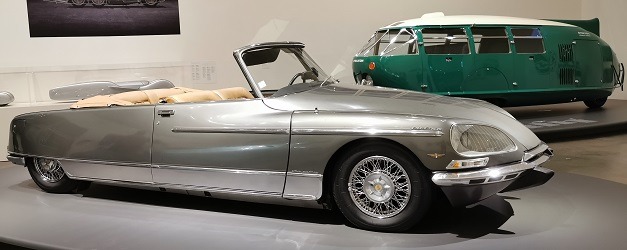
Citroën DS y Dymaxion Car no.4
I thought about coming down from my clouds but, as you can understand me, with this panorama, I couldn’t do it. I had before me the French goddess of cars, a Citroën DS. In French, DS is pronounced as déesse, which means goddess and not desire, even if it generates it. In France, she is not only a goddess, she is also a celebrity and actress due to the number of films from the 60s and 70s in which she appears. In Spain it was baptized as “shark“. When the 50th anniversary of its launch in 2005 was completed, an impressive concentration of this model walked through the streets of Paris. If you don’t see a DS rolling around France, you’ve missed seeing one of its symbols around it, almost like the Eiffel Tower. Without a doubt, it is in the right room of the exhibition, not only for its innovative and futuristic design, very advanced for its time, but also for its support systems for driving, safety and braking. A sculptor (Bertoni), an aviator (Lefebvre) and a technician (Mages), with a team motivated after the war, managed to make the most beautiful car of all time according to Classic & Sports Car magazine. It ranked third in the 1999 Car of the Century competition and fifth place on Automobile Magazine’s 2005 list of “100 Coolest Cars.” The Citroën DS 21 IE Cabriolet Palm Beach that we see at the expo is the last of the 32 that were made by hand by Henry Chapron, manufactured in August 1971. I was very struck by the chrome-spoked wheels, the chrome-plated plastic bezels around the headlights, and its delicate Tudor Gray color.
Not only was I delighted with the color of the Citroën, I was also blown away by the Alfa Romeo that I had in front of me and the one with the orange wedge that was next to it. The Alfa Romeo BAT 7, from 1954, is an Italian concept car that was produced together with two others: the BAT 5 (from 1953) and the BAT 9 (from 1955). Without a doubt, the most striking thing about the car is its shape, especially the inward-curving rear wings. With the acronym BAT I immediately thought of the wings of a bat. The acronym stands for Technical Aerodynamic Berlineta, as Franco Scaglione of the Italian design house Bertone was hired to eliminate the problem of airflow interruption at high speeds. Of the 3 prototypes, this was the one that best managed to reduce the aerodynamic drag coefficient (CD 0.19), although all are considered authentic icons of 20th century automotive design. The craftsmanship is noticeable in many details, in addition to the wings, it has hidden headlights and a fairing around the wheels. Undoubtedly, the aeronautical knowledge of the Bertone and Scaglione houses, and the latter’s experience as a women’s fashion designer, served him well. These studies focused on aerodynamics, when it was still in its infancy, paved the way for new visions in the automotive industry.

Lancia Stratos Zero
The orange wedge or Lancia Stratos Zero, is also a concept car manufactured by the Italian House Bertone, when its chief designer was Marcello Gandini. Some consider it the most beautiful prototype of all time. Others believe it is the Alfa Romeo Carabo, also a Gandini design, with a wedge shape and scissor doors that was made two years earlier. You would have to see the Carabo live and not in photos to be sure, but this Lancia has a very sophisticated design style. The one that I liked the most aesthetically in this whole room. I was possibly influenced by its height, the flip-up windshield to get in and out, the angles that make it look like a spaceship, the windows, the exhaust pipes, and the way it fixes the cooling system. Gandini not only created automobiles, he collaborated in the design of some helicopters, he also worked on industrial design and interior decoration. And music was very present from his birth, his father was an orchestra conductor. In an interview in Automobile Magazine he said that “his design interests are in the architecture, construction, assembly and mechanisms of the vehicle, not in appearance“. However, this car has been present at the “Sculpture in Motion: Masterpieces of Italian Design” exhibition in Los Angeles in 2012. Draw your own conclusions. This prototype gave rise to the Lancia Stratos HF de Rallyes, with a Ferrari Dino engine. He obtained his first victory in the VII Firestone Rally of 1973 in Bilbao.
The car exhibition at the Guggenheim Museum in Bilbao does not disappoint even if you go with that intention. This time not for aesthetics, but for the technologies that these cars offer. General Motors designed 4 prototypes, the Firebird I to IV, of which we only see the first 3 in this room. They were designed as prototypes to experiment with new propulsion methods on a test track. Firebird I is the first in the US with a gas turbine that managed to demonstrate practical feasibility of use. They weren’t looking for more speed or power. Two were made of the Firebird II, one with a titanium body and the other with glass. It was designed to use any type of fuel associated with a turbine engine. It had a guidance system, which theoretically followed the signals of an electrical cable embedded in the road. Two years later, in the Firebird III they manage to test a guidance system to avoid accidents. This two-seater has a gas turbine engine and a gasoline engine. Driving is with a control lever (similar to a joystick) placed between the two seats; and it has an anti-blocking system for wheels and air conditioning, among other novelties to date.
Like these visionaries from the 1950s, we can also see visionaries from today in the show. The car with which Lewis Hamilton took pole position at the 2020 Italian Grand Prix is on show. The Mercedes-AMG F1 W11 “EQ Performance” is the eleventh that the brand has built since 2010, when it returned to Formula 1. It is not only a prodigy in competition, but also as the image of the new generation of hybrid and electric cars from Mercedes. Hence the name “EQ Performance”. In preseason it had a silver and black color; but competed in the 2020 Austrian Grand Prix in black. According to Toto Wolff: “It is a clear statement that we oppose racism and all forms of discrimination“. In clear reference to the murder of George Floyd. Hamilton is a great anti-racist ambassador. You see, cars can be related to many aspects of our daily lives.
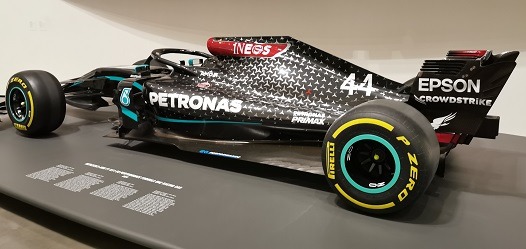
Mercedes-AMG F1 W11 “EQ Performance”
I was goin on withthose reflections, when leaving the room I ran into a sculpture that Humberto Boccioni designed in 1913! This bronze copy is from 1972 from the Tate Modern in London, since the original is made of plaster. It has a lot of strength, and it evokes movement in me, as well as the memory of the air we leave behind as we walk; very much in tune with what we’ve been seeing. The sculpture prompted me to see the paintings that were next to it. There were two that I really liked: Tullio Craly’s The Force of the Curve and Benedetta Cappa Marinetti’s Speeding Motorboat. Both made at the beginning of the 20th century. Once again, the close relationship between the automotive industry, technology and art is present. These cars definitely broke and assumed “the state of the art“.
In a last look at these visionary cars, I missed any allusion to the Basque electric car Zeus, developed in 1996 by the Electronics Department of Corporación Mondragón and Iberdrola. I also remember the Hiriko, the citycar from Mondragon University, the e-train and iebus electric buses from Irizar and Solarius-CAF for the world. Or the Zacua, which, being a Mexican electric car, its entire engineering and innovation concept was carried out in 2017 in the Basque Country by the Dynamik Technological Alliance. The Basque automotive sector has a significant number of public and private technology, innovation and R&D units or centres, which are suitably linked to the main business groups and SMEs. A clear example is the Automotive Intelligence Center (AIC) which, more than a research center, is a center of innovation in the automotive sector. Today they are working on current and future issues such as digitization, electromobility, hydrogen, etc. He is also one of the collaborators in this car exhibition at the Guggenheim museum in Bilbao. In addition to Mondragón Automoción and Irizar, which I have already mentioned, other companies or groups in the sector have research and innovation groups such as: Gestamp, CIE Automotive, TENNECO, Teknia, GKN DRIVELINE, BRIDGESTONE, ZF, PIERBURG, GUARDIAN GLASS, PMG…
American Life
The American room presents us with 4 automobiles that characterize their influence on life and society in the United States. The impact of the automotive industry worldwide in the 20th century and so far in the 21st has been and it is overwhelming, but in the United States, moreover, it is molecularly interwoven with its own cultural identity. And these cars represent it in all its splendor.
With the name of the room in mind, I was surprised that the first car that caught my eye was named after the Basque city of Biarritz and a legendary Latin American city known as El Dorado. The stunning red Cadillac Eldorado Biarritz captures your eyes, mind and heart. I was delighted that the first thing we see of the car is its huge pointed wings with its double headlights that could propel fire instead of just lighting up. It is noted that Harley J. Earl comes from the body world, and is recognized as the stylist of General Motors. The pioneer of tail fins. Could the Firebirds that I just saw in the Visionaries room that were also under your direction have had something to do with them? It is possible that this is not the case, since they say that the inspiration for the ailerons came from a famous American bomber.
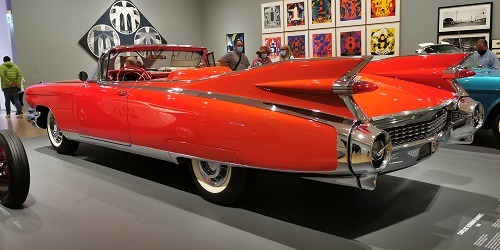
Cadillac Eldorado Biarritz
Fashions are repeated, and the colossal shape of this car, we see again today on our streets. It looks like an ocean liner for highways. The chromes are also striking, especially the two stripes that cross the car from end to end, one on each side. The Biarritz name that Cadillac gave to its convertibles is very apt, surely inspired by the sign of social wealth and glamor that this French Basque seaside resort represents. I wouldn’t be surprised to see Marilyn Monroe or Elvis Presley driving around in one of these cars, as they say they had. Surely other musicians and actors also shone in them, because it is a car with art.
The Pierson brothers were also very artistic when they modified a 1934 Ford in 1949, which finally achieved its fame on the racetracks. Although it draws attention with its unusual turret and its shape, the Ford Pierson Brothers Coupe also represents the culture of the USA very well. Its colors of the American flag and the story of its transformation from an ugly duck (they bought it for 25 dollars) to a swan, is worthy of a film from this country. It was the fastest closed car in the US for a few years. And then he fell back into oblivion. In 1980 Tom Bryant brought it back for dirt racing, upgrading some safety features. And in 1992, its current owner, Bruce Meyer, returned it to the same state that the Pierson brothers left it, who also advised on that update. Several times it has had to transform so that today we can see it in this expo.
Another impressive restoration has been the 1965 Ford Mustang Project 50 that is next to the Cadillac. The Haynes Motor Museum restored it in 2010 to commemorate the 50th anniversary of Haynes repair manuals; hence its name Project 50. They bought a red 1965 Ford Mustang convertible with a 289 V8 engine on eBay. The restoration process they have carried out is impressive. Design chief Joe Oros wanted a car that would appeal to women and be desired by men. And they did! They came to sell more than 10 million cars. Oros also wanted it to be associated with European design, especially Ferrari and Maseratti. For me, the original turquoise color, that it is convertible and its elongated hood is what I liked the most about this car.

Willys MB
In a room dedicated to American life, a nod to the military power that is the United States could not be missing. And without a doubt, an army jeep is the best representative of it in this exhibition. The Willys MB has been manufactured by Willys and Ford after homologating an all-terrain vehicle with all its dissimilar features for a war. The commercial version of the Willys MB was the Willys Jeep, which would finally impose its name on this type of vehicle. They say that being a «General Purpose» vehicle; GP sounds like yippie, and hence Jeep. I prefer another version that associates him with Eugene the Jeep, the magical dog of Olivia, Popeye’s girlfriend. In Latin America and Spain it was known as Eugenio el Genio, the one who goes anywhere, like this car.
As for the art proposals proposed by the curators of the car exhibition at the Guggenheim Museum in Bilbao, there are 3 themes that caught my attention. Ogle Winston Link’s photograph titled Steam Train Traveling East, Iaeger, West Virginia for its technical quality even when taken at night and because it incorporates the concept of movement in 3 types of transportation: car, train and plane. Also the sculpture that is hanging on the wall, by John Chamberlain, called Dolores James, from 1962. It is an abstract 3D painting made with pieces of cars. The work appeared at the end of the 1950s, when Junk Art appeared, in which the residues of society began to be used in the arts. Chamberlain focused more on the poetry that his debris sculptures aroused. But I think that they also have a vindictive component about waste and not recycling waste properly.
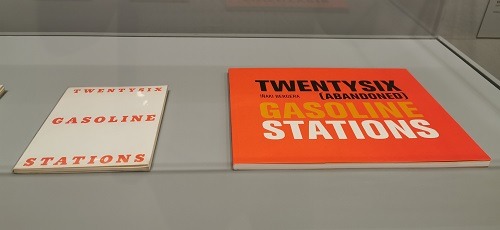
Twenty Six Gasoline Stations
The best surprise of the exhibition was when I found myself attracted by a 7-color serigraph by Edward Ruscha: Standard Gas Station (Standard Station), 1966. Not only because of the theme, but also because of the gradation of tones that it makes in the background of the image. construction site. The serigraphy is based on one of the 26 photos that Ruscha took in 1963 of gas stations, located on the mythical Route 66. He published them in a book entitled Twenty Six Gasoline Stations. Right next to this book was another called the same, but with an additional word Abandoned incorporated and in parentheses. The author was Iñaki Bergera! A fellow Basque from my hometown Vitoria-Gasteiz! In addition to the book, several photos of those abandoned gas stations from 2012 are shown. Unlike Ruscha, Iñaki pays homage to him, with photos that denounce his state of crisis and abandonment. And as a good architect, his notions of perspective, composition and aesthetics are noticeable. I remembered the Goya service station, in the rationalist style of 1935, in Parque de La Florida in Vitoria-Gasteiz. Another good example of the union between architecture and the automotive industry.
Sound, clay and future of automotion
Although there are no more rooms with cars. The exhibition is still nourished by 3 more areas with interesting content.
Normally, the Guggenheim Museum in Bilbao associates a didactic area with each important exhibition it organizes. In this case, in the corridor that connects to the room of the future of mobility, you can hear the engines of 10 of the cars that you have just seen in the rooms. Pay attention, a light comes on to indicate the car you are listening to. Nick Mason, a former member of Pink Floyd, led the group that designed this sound experience. There is also a video, coordinated with the sound of the cars, in which you can see how they were created or captured.

Learning Area – Sound of cars
Through the same corridor you access the room of the Future and a section of a replica of a clay modeling workshop. The current clay workshop is as it was done before, and as it is still done now. New technologies have failed to replace it. In the exhibition they show us a clay model of the Cadillac LYRIQ EV. In addition, a video gives you more information on the subject. The art of these modelers is still alive.
The room of the Future transports us to the end of the 21st century with proposals from 15 international schools of design and architecture. They were challenged to show their visions of the future of mobility. Addressing issues such as urban congestion, resource scarcity, and pollution. I will only stop to highlight the most local ideas and those that most caught my attention. I suggest you start the tour of this room on your right, because you will see everything with a chronological sense. The third proposal, that of the University of Tokyo, was the first that I loved. An ecosystemic urban design of Tokyo where various forms of current and future mobility coexist. I think it is an excellent solution to maintain continuity between past and future.
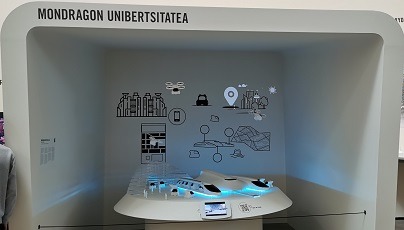
Mondragon University and the CAF Group
The University of Mondragón and the CAF Group (Construction and Auxiliary of Railways), both Basques, present us with their idea of the train of the future. A train that offers personalized experiences and is efficient through “door-to-door” transportation. Be sure to download the app so you can see in 360 degrees how the proposal is in motion. I loved it! The University of Monterrey, for its part, offers us 3 new types of mobility: open (rather than clean), distributed (rather than shared), and citizen (rather than urban). A fairer and more equal mobility. A systemic mobility for a new era.
As you can understand, with these wickers it was impossible for me to set foot on Earth again until my stomach (and not a car) placed me in time and space. It was already lunchtime, and if I didn’t pick up the place, I was left without tasting a good dish of Basque cuisine. Another activity where art and technique are consubstantial to its essence, as in the automotive industry.
Contact me if you want to make a personalized and private visit with me to this car exhibition at the Guggenheim Museum in Bilbao. Open until September 18 of this year 2022. Or contact if you want to make a visit to the city or its surroundings.
Note: The revision of this second part has also been carried out by Miguel Martín Zurimendi, a researcher in the history of the automotive industry. Thank you very much Miguel!

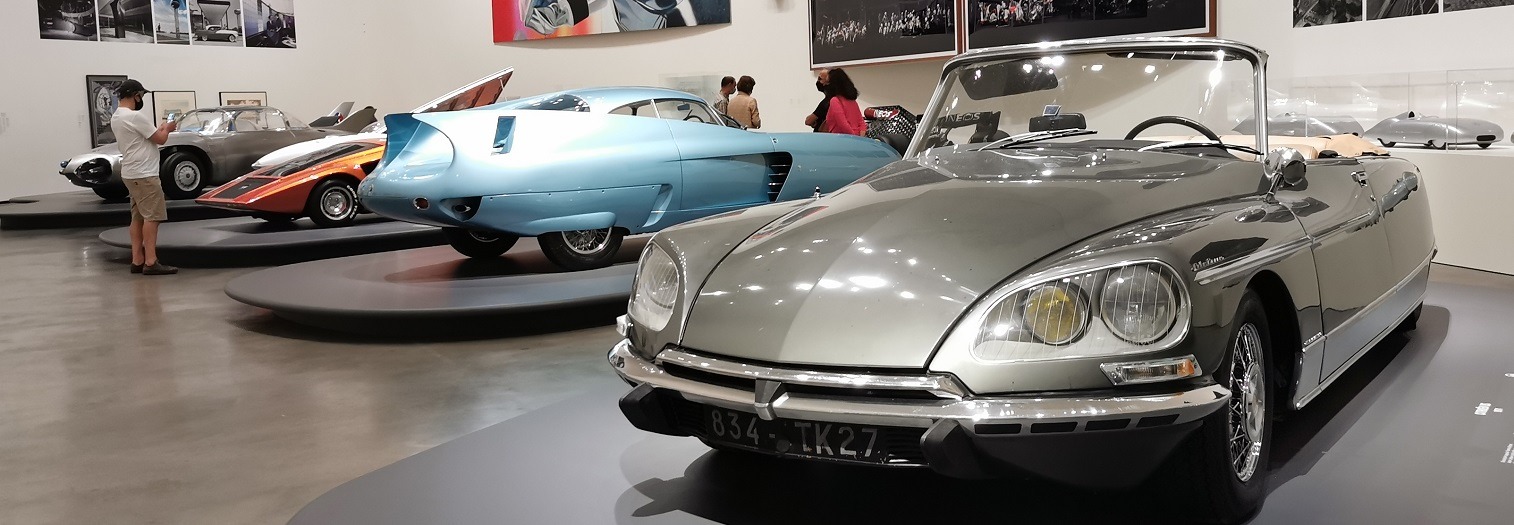
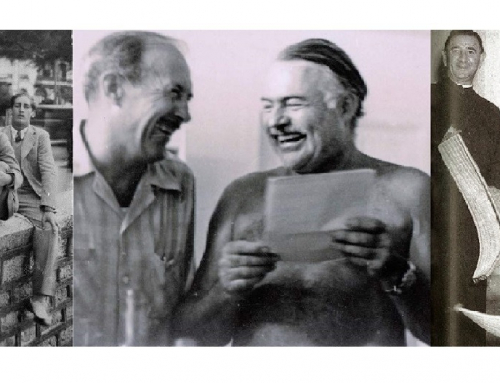
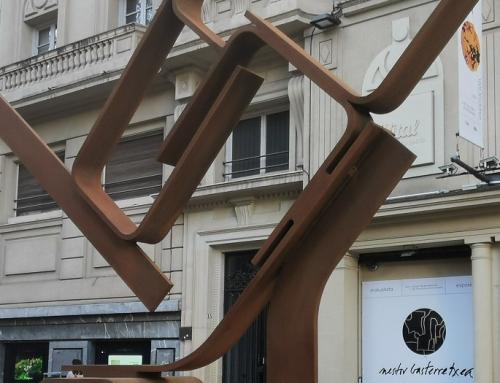
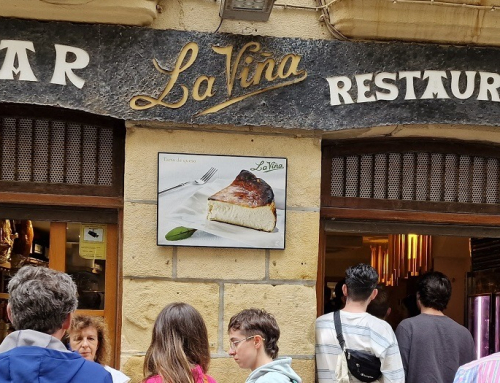

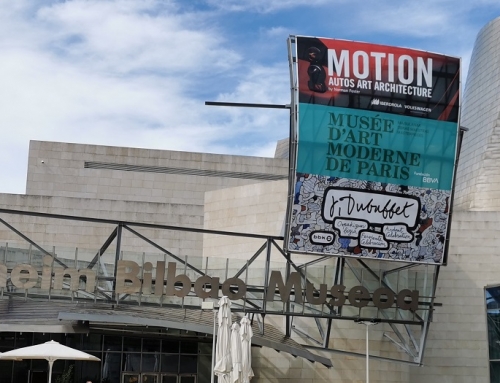


Leave A Comment